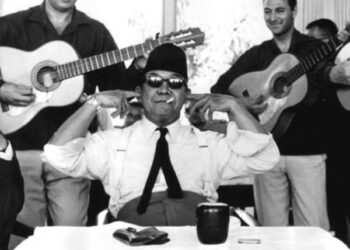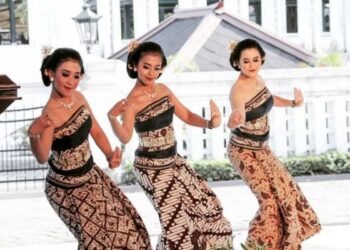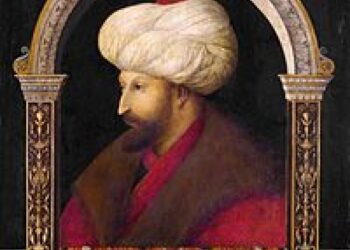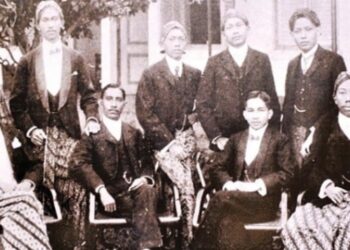West Irian region is an area that cannot be separated from the Unitary State of the Republic of Indonesia (NKRI). However, until the event of recognition of sovereignty from the Netherlands to Indonesia, West Irian was still under Dutch control. Therefore, it is also fighting for regional liberation. If classified there are two strategies for the Liberation of West Irian, namely diplomacy and armed struggle.
A. Diplomacy Struggle :
1. Attempted Negotiations with the Dutch
According to the terms of the Dutch–Indonesian Round Table Conference (Konferensi Meja Bundar), the West Irian issue was postponed a year later. Therefore, at the time of the sovereign recognition ceremony, the west Irian region was not included as RIS(Republik Indonesia Serikat) area.
Based on KMB(Konferensi Meja Bundar) decision, at the end of 1950, there was already a Dutch effort to return West Irian to the Indonesian side. However, it seems that KMB(Konferensi Meja Bundar) decision related to West Irian did not go smoothly. The Dutch seemed keen to keep West Irian. Therefore, Indonesia sought to restore West Irian through diplomatic efforts and direct talks with the Dutch. Some cabinets during the liberal democracy also had a program of returning West Irian to the lap of the Republic of Indonesia.
Each cabinet tried to negotiate with the Dutch. The negotiations were for example, during the cabinets of Natsir, Sukiman, Ali Sastroamidjojo, and Burhanuddin Harahap. Even during the cabinet, Burhanuddin Harahap held a meeting between the Foreign Minister son of Agung and Luns in The Hague. However, the negotiations did not succeed in restoring West Irian.
2. Diplomacy through the United Nations
Since 1953 struggling through the United Nations forum has been enforceable by Indonesia. The issue of west Irian every year is always proposed to be discussed in the UN General Assembly. Until December 1957, efforts through the UN forum were also unsuccessful. Why in the vote, Indonesian supporters did not reach 2/3 of the number of vote’s at the UN General Assembly.
3. Establishment of An Interim Government
The struggle for the liberation of West Irian was also pursued through domestic politics. To coincide with the 11th Anniversary of the Proclamation of Independence of the Republic of Indonesia, on 17 August 1956, Ali Sastroamijoyo’s Cabinet formed the Provisional Government of West Irian. The purpose of the formation of an interim government, in this case, is the declaration of the establishment of the Province of West Irian as part of the Republic of Indonesia.
The province of West Irian was formed to include the Dutch-occupied Irian region plus the Tidore, Oba, Patani, and Wasile areas in North Maluku. The government center of West Irian Province is locating in Soasiu, Tidore Maluku. As governor of Sultan Zaenal Abidin Syah (Sultan Tidore). His inauguration took place on September 23, 1956. As a result of the formation of an interim government of West Irian Province, among others, the Netherlands became increasingly politically distressed. Besides, the Dutch realized that western Irian was a sovereign part of Indonesia.
4. Strike and Nationalization of Various Companies
Apart from going through the political field, the struggle to liberate West Irian was also launching through the socio-economic sector. During the struggling to return West Irian through the UN General Assembly in 1957, the Indonesian Minister of Foreign Affairs, Subandrio, stated that he would take another path. The other way that Subandrio meant was not a weapon but an economic confrontation. On 18 November 1957, the West Irian liberation movement was held by holding a general meeting in Jakarta.
The public meeting was following by a total strike by the workers working for the Dutch companies on 2 December 1957. After that, there was a series of taking over (nationalizations) of capital and various Dutch-owned companies. The take over was initially carried out spontaneously by the people. However, later regulated by Government Regulation no. 23 of 1958. Some examples of companies that were taken over by Indonesia, among others :
- Banking like Nederlance Handel Maat Schappij (now known as the State Trade Bank)
- Shipping Companies
- Philips Electric Company
- Several Plantation Companies
To increase the movement and strengthen the unity of the Indonesian people on 10 February 1958, the government formed the West Irian Liberation National Front.
B. The Struggle with Weapon Confrontation
West Irian has not been politically successful, for that Indonesia is looking for another alternative, namely the struggle with weapon confrontation. What is meant by weapon struggle? To answer this question, we can study the following statement:
1. Operation Trikora Liberation of West Irian
Various ways and efforts of Indonesia to liberate West Irian have not shown tangible results. The Dutch are getting tough and don’t want to budge. The Netherlands later stated that West Irian was a Dutch territory as part of the Nederlands. By the Dutch, West Irian was called Nederlands-Nieuw Guinea. Faced with the fact that various means have not been successful, Indonesia has stepped up confrontation in all fields. On 17 August 1960, Indonesia broke off diplomatic relations with the Netherlands.
The struggle for the liberation of West Irian more further directing by military means. To deal with confrontation, the government entered into arms purchase agreements from abroad, such as with the Soviet Union. Apart from that, Indonesia is also seeking support from other countries.
Seeing Indonesia’s actions, the Netherlands did not remain silent. In April 1961, the Netherlands formed the Papua Council. This council will organize self-determination for the people of West Irian. Even further, the Netherlands showed its courage and strength by taking the following steps :
- Form a Papuan Puppet State with Papuan songs and flags.
- The Dutch helped and sent troops with his battleship into the waters of Irian, including the ship Karel Doorman.
- Strengthening the Dutch army in West Irian.
With that fact, the military struggle for the liberation of The West seems inevitable. On 19 December 1961, through meetings with Army Commanders, and Cabinet in Yogyakarta, President Sukarno launched TRIKORA (Tri Komando Rakyat), and the following contents of TRIKORA :
- Abort the formation of the Papua Puppet State
- Raise the Indonesian Flag in West Irian.
- Get ready for massive mobilization to defend the independence and unity of the Indonesian Motherland.
2. Military Operations under Mandala Command
As a follow-up to the TRIKORA program, President Soekarno formed the Mandala for the liberation of West Irian. It was on 2 January 1962, led by Major General Suharto. The center of the Commandos Mandala is at the tip of view to carry out Trikora. To carry out this task, the Mandala Command takes the following steps: a. plan, prepare, and carry out military operations. b. developing the military situation in the West Irian Province.
To prepare for military operations. Mandala Command has been a stage of the struggle. From March to August 1962, ABRI troops and volunteers from sea and air began landing troops in their place, for examples:
- Operation Banteng in Fak-Fak and Kaimana
- Operation Srigala in Sorong and Teminabuan
- Operation Naga in Merauke
- Jatayu operations in Sorong, Kaimana and Merauke
During the preparation and infiltration stages, there was a battle incident in the Aru Sea on 15 January 1962, At this situation Indonesian boat, the Tiger Tutul, which was on patrol, was attacked by the Dutch. There was a battle, the Indonesian ship Macan Tutul caught fire and sank. In this incident, Commodore Yos Sudarso and Marine Captain Wiratno were killed in action. The infiltration movement continues. Troops began to land and control several areas in West Irian. Here are the volunteers and volunteers. The Indonesia flag began raised in various regions.
3. Bunker Plan
Seeing the Indonesian troops, the Dutch began to worry and became overwhelmed. The international world knows and begins to worry that the United States is starting to pressure the Netherlands to want to negotiate. Ellsworth Bunker, a US diplomatic appointed as mediator. The bunker then proposed the points of peaceful settlement of the West Irian problem. The main point of the proposed bunker includes the following.
- The Netherlands will hand over West Irian to Indonesia through the UN agency, namely UNTEA (United Nations Temporary Executive Authority)
- Granting the right to the people of West Irian to determine their opinion on the position of West Irian.
The main point is known as the Bunker Plan. Based on this plan, on 15 August 1962, an agreement was reached between Indonesia and the Netherlands, known as the New York Agreement
The contents of the New York Agreement includes:
- The Netherlands must have submitted West Irian to UNTEA by 1 October 1962, the Dutch flag is replaced with the UN flag
- The troops who were already in West Irian remained in West Irian and were under UNTEA control
- The Dutch army was gradually withdrawn and returned to the Netherlands.
- The Indonesian flag began to raise up in West Irian alongside the UN flag on 31 December 1962.
- The Government of Indonesia will accept the government of West Irian from UNTEA by 1 May 1963.
4. The End of the West Irian Confrontation
After the negotiations in New York, came the government for a shootout between the two sides. Thus Operation Jayawijaya was canceled. As a result of the new york agreement, the Dutch formally submitted the western irian to UNTEA. On 1 May 1963, the United Nations handed over West Irian to Indonesia. The submission was on the condition that the Indonesian government holds a levy on people’s opinions. Thus, the Dutch ended power in Indonesia. And then West Irian was changed to Irian Jaya and joined the Republic of Indonesia.
Writing Conclusions
The struggle for the liberation of West Irian has been going on for quite a long time, from the KMB (1948) to the determination of people’s opinion (Pepera 1962). The political struggle was carried out through direct negotiations with the Netherlands, diplomacy through the United Nations, strike movements, and the nationalization of Dutch-owned companies in Indonesia. The military confrontation was triggered at a rally in Yogyakarta. in the general meeting, president Sukarno promoted the TRIKORA (Tri Komando Rakyat). The implementation of military operations was led by Komando Mandala. The bright spot for the struggle for the liberation of West Irian was after the Bunker Plan and the New York agreement on August 15, 1962. The struggle for the liberation of West Irian was marked by the existence of UNTEA and the implementation of the Act of Free Choice (Penentuan Pendapat Rakyat).
















